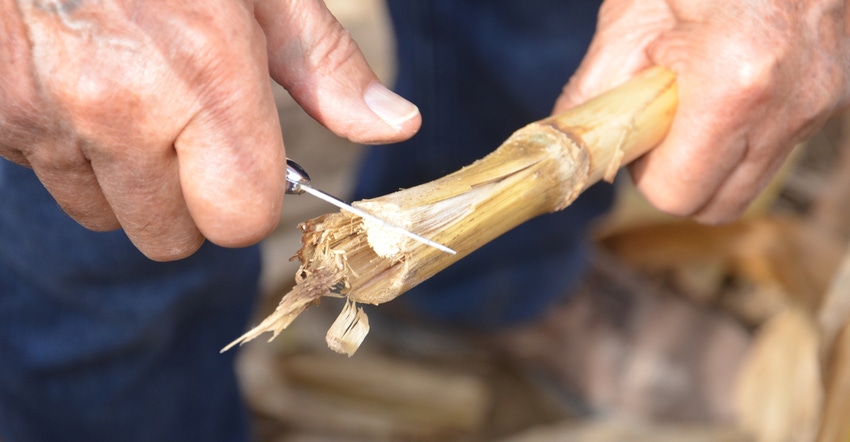September 2, 2020

Lots of cornfields have been affected by gray leaf spot because of high temperatures and humidity. If you had leaf diseases, you probably will have stalk rots unless you aggressively controlled the disease with fungicides.
Leaf diseases predispose plants to stalk rots. Knowing what’s out there may help you prioritize harvest:
Anthracnose leaf blight and stalk rot. These diseases are caused by the fungus Colletotrichum graminicola, which overwinters in corn debris. As a leaf blight, it produces long, wavy lesions and can move to stalks. The stalk rot is identified by shiny black spots near the base of plants. Spots move up to several internodes. This fungus produces microscopic spores and gives the rind a black shine like shoe polish. Affected stalks decay inside and eventually lodge. Premature plant death interrupts grain fill and causes yield loss. Anthracnose is one of the most important diseases in the Corn Belt.
Diplodia stalk rot. This is caused by the fungus Diplodia maydis, which also causes ear rot. Infections can occur within two weeks after silking. The ear rot usually starts at the base of ears. Eventually the whole ear may rot. When husks are peeled back, a white mold is visible between kernel rows. Shanks and husks of affected ears look bleached and whitish. The base of the stalk produces small black dots called pycnidia. They’re embedded in the rind and can’t be scraped off.
Fusarium and gibberella stalk rots. The fungi causing these diseases are Fusarium moniliforme and Gibberella zeae. In the field, it’s difficult to distinguish between these two rots. Both can infect ears and stalks. Pathogens overwinter in old roots and stalks. Ears are infected at tips first. Pathogens attack the base of stalks through roots. Inside tissues and fibers deteriorate, and tissue is soft and pink-to-reddish.
Charcoal rot. This is caused by the fungus Macrophomina phaseolina, which infects plants near maturity. It begins as a root rot and moves to lower internodes. Stalks have black fungal bodies known as sclerotia that look like charcoal dust. Stalks die and lower internodes disintegrate.
Pythium stalk rot. This disease is caused by Pythium aphanidermatum and other pythium species. It occurs during hot and wet weather during summer. It usually infects a single internode near the soil line that collapses.
Scout and test
To determine if stalks are severely infected with disease, conduct the pinch or push test. For the pinch test, simply pinch stalks one after another and determine how many are soft and have lost integrity.
For the push test, push stalks to the side. If they bounce back, they’re still healthy. If they remain leaning or fall over, they’re likely infected with stalk rot.
For either test, sample 100 stalks in a row. Then reverse direction and test 100 stalks in a different row. For example, if 10 of 100 stalks fail the test, then infection is 10%. Repeat the test at random locations within the field.
Nanda is director of genetics for Seed Genetics Direct, Jeffersonville, Ohio. Email [email protected] or call 317-910-9876.
About the Author(s)
You May Also Like






